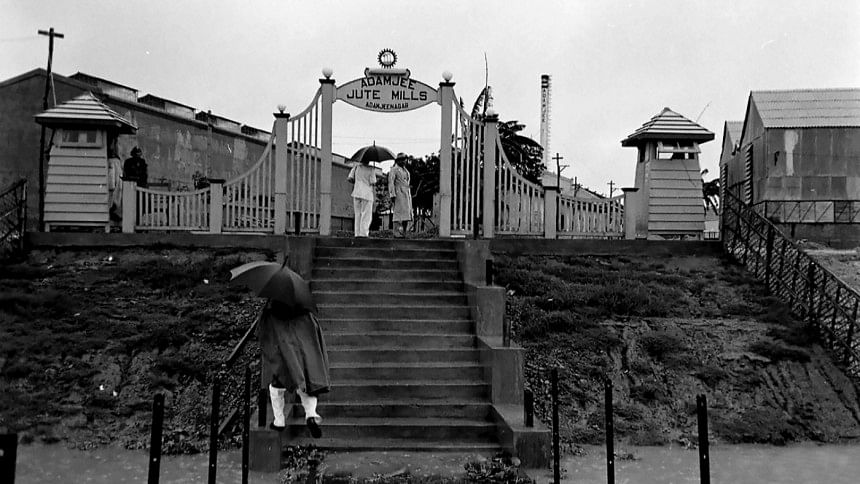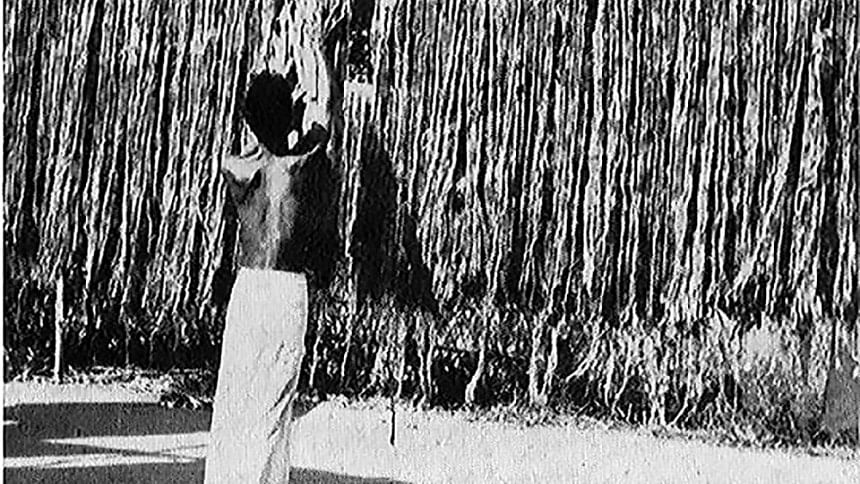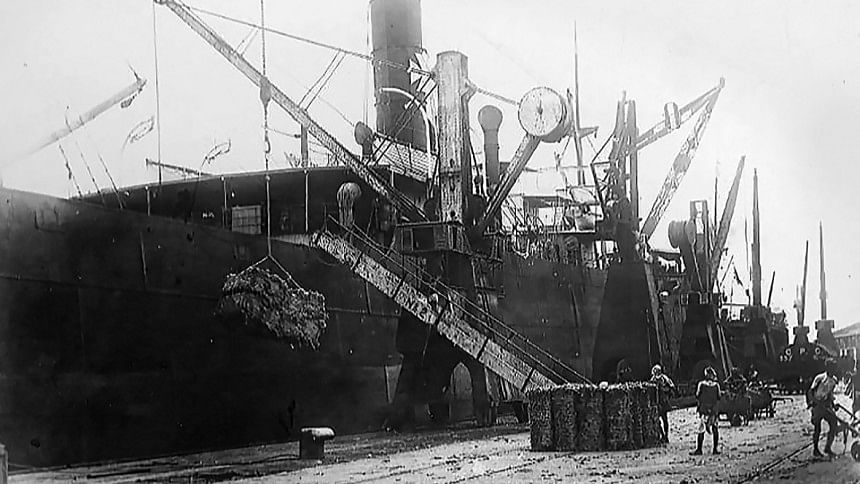Unthreading Partition: The politics of jute sharing between two Bengals

The Partition of British India (1947) had complex and wide ranging implications for the jute economy of deltaic Bengal. The border between East Pakistan and India separated Bengal's jute fields from the jute factories. East Pakistan received more than 75 percent of the total jute growing land of undivided India, whereas all the mills were in India (most-near Calcutta—in the districts of Howrah, Hooghly and some in the 24 Parganas). Moreover, Calcutta was practically the only port through which the Bengal jute used to be exported. Most jute baling centres were also located in and around this city. Thus, during Partition, the jute economy of Bengal ran into the risk of being fragmented.
The policymakers sitting in Delhi and Karachi, Calcutta and Dhaka, were eager to avoid an economic crisis at this critical juncture. A "Standstill Agreement" (valid till March 1948) was signed between India and Pakistan which meant that there would be no export/import duties on any commodity moving between these two dominions. Jute was covered by this agreement. In other words, the new international border was not supposed to have any immediate impact on the jute industry. But the agreement was too fragile to last for more than a few months. Conflicts erupted between the two dominions when East Pakistan, as the chief producer of raw jute, demanded a share of the annual revenue that the Calcutta Port earned from exporting it. When India did not agree, East Pakistan began to levy a duty on the fibre (December 23, 1947). Fourteen land customs collection centres were operating in East Pakistan by the end of December 1947 for the collection of this export duty. Thus began the disentanglement of the long established network of jute circulation. For the next one and a half years, India and Pakistan remained engaged in various negotiations regarding the transactions of raw jute and jute products across the Radcliffe Line. But it was in September 1949, when the world of jute faced the full brunt of Partition.

Till September 18, 1949, a pound was equivalent to 4 dollars 3 cents; henceforth, it became equal to 2 dollars and 80 cents. In reaction to this, India devalued her currency instantaneously but Pakistan did not. For the first time an Indian rupee was not equivalent to a Pakistani rupee. This created the following problem for the jute business in the subcontinent and beyond: Pakistan continued with its previous prices for the raw jute which meant that Indian mills now had to pay 44 percent more. The Indian authorities decided to fix the maximum buying price at INR 35 (equivalent to around PKR 15.5) per maund of jute from East Bengal (1 maund = 37.32 kg). The Pakistan government, in its turn, declared PKR 23 to be the minimum selling price for every maund of raw jute at the baling centres till June 30, 1950. A simple mathematical calculation would reveal that the Government of Pakistan was asking around PKR 7.5 more than the Indian mills' sanctioned price. The situation further deteriorated when the Pakistan government seized 60,000 bales of Indian jute that were coming to Calcutta from Assam through Pakistan. Moreover, five lakh bales of Pakistani jute for which Indian merchants apparently had paid before devaluation were also detained as there was not enough proof of payment.
To pressurise Pakistan to resume its jute supply, the Indian government decided to stop coal supply to Pakistan towards the end of December 1949 (Pakistan received 23 million tonnes of coal from India annually at that point). Thus a full-fledged trade war began. Some of the immediate consequences of the coal-scarcity were long hours of black-out in Dhaka, a sharp increase in the price of kerosene, and a slowing down of work in the jute-baling centres. To limit coal consumption, several Calcutta bound trains were cancelled. Moreover, trains became infrequent along the North Bengal lines that were used for travelling from Calcutta to Siliguri and beyond. The number of steamers plying between various river ports of East Bengal and Goalundo was also reduced, making the journey between the two Bengals difficult. It seemed that India and Pakistan were heading towards a severe diplomatic crisis.

Amidst this jute-coal conflict, an incident in the village of Kalshira in the district of Khulna further complicated the politics of the time. On December 20, 1949, the police assaulted a Namasudra family of this village, because of their alleged Communist associations. In the scuffle, a constable was killed. On the following day, the police attacked the village, which was primarily a Namasudra settlement. The incident took a communal turn when local Muslims also attacked Namasudra houses. Soon the riot spread across East Pakistan. The situation worsened early next year when riots broke out in different parts of West Bengal and Assam. Known as the February Riots, this was the first major communal incident affecting eastern India and East Pakistan since Partition. Though the Kalshira incident is seen as the immediate trigger for the riots of 1949–50, several contemporary accounts cited the ongoing jute-coal crisis as one of the reasons behind the communal tension. That 60,000 maunds of raw jute were burnt down at a baling centre of Narayanganj on January 6, 1950 by a group of rioters, or that the jute mill areas of West Bengal were the worst sites of communal violence at this time, were not mere coincidences. Jute had now become both a cause and a symbol of animosity.
With the total breakdown of Indo-Pak jute diplomacy towards the end of 1949, an acute shortage of the packaging material was felt across the world. With the beginning of the Korean War, the need for jute or jute substitutes became even more serious.
The widespread riots and the severe economic crisis brought India and Pakistan to the negotiating table once again. An agreement (the Nehru-Liaquat Pact) was signed between the two prime ministers (April 8, 1950) to address the communal situation. Additionally, the commercial transactions between India and Pakistan also resumed. It began with the shipment of West Bengal's detained jute, and India released coal to steamer companies to carry that jute over to Calcutta. Coal was specially supplied to the steamers for carrying refugees from East Bengal to West Bengal. Finally, a formal trade agreement was signed at Karachi on April 21, 1950. According to this, the Pakistan Jute Board was committed to supply 4 million maunds of raw jute to the Indian mills in return for 20,000 tonnes of jute manufactures from India. The agreement was warmly welcomed by the Indian Jute Mill Association as the stoppage of raw jute from East Pakistan had severely hit the mills of Calcutta. But it did not signal a happy ending to the ongoing jute war. India and Pakistan signed and breached repeated trade agreements on jute throughout the 1950s. It was rapidly becoming clear that neither of these two neighbouring countries was capable or willing to work as a unit when it came to raw jute production or jute manufacture. They were desperate to become independent of each other as soon as they could.
For India, developing a self-contained jute economy would mean increasing the production of raw jute. A "Grow More Jute Campaign" was launched soon after Partition. As a part of this programme, sustained attempts were made to grow jute beyond West Bengal and Assam—the traditional jute growing areas of India. Free seeds were distributed among the peasants of Madras, Travancore and Bombay. Simultaneously, in West Bengal a substantial number of paddy fields was converted to jute producing areas. Between 1950 and 1952, according to the figures provided by the agricultural department of West Bengal, 243,000 acres of paddy land were diverted to jute. Producing jute at the expense of paddy was not a prudent decision in West Bengal—a state that had been separated from the fertile paddy fields by the Radcliffe Line. Scarcity of food grains would remain a burning issue in West Bengal politics throughout the 1950s and 1960s culminating into two major food movements (1959 and 1966).
Likewise, in East Pakistan, initiatives were taken to develop a self-sufficient jute industry. New baling presses were ordered within a few months of partition. In 1951, three jute mills, namely Bawa Jute Mills Ltd, Victory Jute Products Ltd and Adamjee Jute Mill, began to operate. The government was quick to pay attention to the facilities available at the Chittagong Port. Before partition, Chittagong Port handled an average of 2 lakh bales per year. Between July 1948 and June 1949, according to the government figures, the handling facilities of this port increased to 1 million bales. From January 1948, ships began to be regularly loaded at Chittagong for American, Australian, Italian, British and Canadian ports. By then a few "all weather barges" had been introduced in Chandpur, Narayanganj and Khulna to carry jute from baling centres to Chittagong Port. The government was also contemplating better railway connectivity between Chittagong and jute baling centres. With baled jute declared as a "class I priority" commodity for the railways, maximum priority was to be given to transportation of jute from baling centres to Chittagong.
In East Pakistan, jute emerged as the site of more intense governmental intervention during the devaluation crisis. The absence of India—the largest client for Pakistan's jute—from the market meant a sharp fall in jute prices in East Pakistan. To deal with this crisis and other related issues, a three-member jute board was formed. An ordinance was issued by the end of November, allowing the government to determine the minimum selling prices for jute and also to appoint purchasing agents. By mid-December, the province had 68 purchasing agents buying jute directly from the growers with advances from the National Bank of Pakistan. The agents were particularly active in the border region. They were instructed to buy all the jute within 10 miles of the India-East Pakistan border. This step was taken to curb smuggling of raw jute to India. Smuggling remained a major concern for the authorities of East Pakistan as the whole purpose of the trade war of 1949-50 would be defeated if they failed to curb it.
Smuggling in jute remained a major concern for the Pakistani state throughout the 1950s. The government issued repeated orders, deployed army and militia, formulated draconian laws, and increased surveillance to stop it. However, no amount of state intervention could completely curb the "illicit" border trade. The Jute Board's inability to ensure fair prices to the cultivators was one reason behind the proliferation of smuggling. The rapidly shrinking Indian market, absence of alternative big market and pressure from industrialists like Adamjee and Ispahani were the reasons behind the Jute Board's failure to safeguard peasants' interest. Since it was heavily dominated by people from West Pakistan, the leaders from East Bengal also accused the board of indifference towards the peasants of Bengal.

Though it is undeniable that jute provided a major entry point for state building initiatives in East Pakistan and eastern India, the attempts to develop two self-contained jute economies did not prove beneficial for either of these countries in the long run. While India and Pakistan were busy developing their self-sufficient jute networks, the world ironically was moving away from Bengal's golden fibre.
In their attempts to nationalise jute, India and Pakistan emerged as unreliable suppliers of this fibre and jute products. Across the world, attempts were made to find suitable substitutes and other suppliers.
Many countries had begun to experiment with substitutes like paper and kenaf during World War II when the supply of jute and jute products became uncertain, particularly in the United States. Partition intensified this trend. With the total breakdown of Indo-Pak jute diplomacy towards the end of 1949, an acute shortage of the packaging material was felt across the world. With the beginning of the Korean War, the need for jute or jute substitutes became even more serious. Various jute substitutes were tried by different countries in response to this crisis. An article published in the Economic Geography in 1950 listed at least 19 natural and synthetic fibres that were being used, though in a limited quantity and on an experimental basis, as alternatives to jute. Another article published in 1952 in the same journal informed how besides kenaf, various experiments with other soft fibres were going on in different countries. New Zealand was experimenting with Phormium tenax (an evergreen perennial plant native to New Zealand and Norfolk Islands); research was going on with Sisal in East Africa (a fibre crop that grows in Brazil, Kenya, and Tanzania). By 1953, the Australian government had invested in commercial kenaf cultivation in the islands of Papua, New Guinea (Times of India, July 22, 1953).
A study on the trends in world demand for jute manufactures outside the principal raw jute–producing countries (i.e., India and Pakistan) presented a bleak picture. Conducted by the National Institute of Economic and Social Research, London in collaboration with the Food and Agricultural Organization of the United Nations, it concluded that the importance of jute as packaging material had declined in the main industrial countries as the "substitution effect has been adverse to jute". After analysing the available data, this study predicted "a decline of 40–60 percent in the jute consumption ratio between 1957 and 1965–70 in industrial countries". In the jute producing countries like India and Pakistan, it predicted "some decline…a decline of 10–20 percent". (1) Thus, the glorious days of jute were over, and partition had a significant role to play in this.
As jute transformed from a "colonial commodity to a national resource"—to borrow Tariq Omar Ali's words (A Local History of Global Capital: Jute and Peasant Life in the Bengal Delta, 2018)—it acquired new meanings. From golden fibre, jute became a symbol of communalism and jingoism, regional politics as well as state oppression. But in their attempts to nationalise jute, India and Pakistan emerged as unreliable suppliers of this fibre and jute products. Across the world, attempts were made to find suitable substitutes and other suppliers. So, when the subcontinent had developed the infrastructure to sustain two self-contained jute economies, the golden fibre had lost most of its glitter. It goes without saying that the consequences would be devastating for the mill workers and the peasants of both the Bengals. But that is a story that needs to be told separately.
Note:
1. An article titled 'Trends in World Demand for Jute Manufactures' (1961) was published in The Pakistan Development Review (1:1, pp. 80-91) on the basis of this research. The citations are from this article. The author's name is given as A.M.G.
Anwesha Sengupta is Assistant Professor at Institute of Development Studies, Kolkata.
This is a shorter version of an article that the author wrote in the Economic and Political Weekly. The EPW article was published on January 27, 2018 and had the same title. For the details of primary and secondary sources the reader is requested to consult the EPW article.

 For all latest news, follow The Daily Star's Google News channel.
For all latest news, follow The Daily Star's Google News channel. 



Comments